Front Matter
Prefaces
Preface to the Second Edition
Table of Contents
2. Dynamic Systems Control
2.1 Feedback Control Systems
2.2 Classical Frequency-Domain Methods
2.2.1 Root Locus Method
2.2.2 Frequency-Response Methods
2.2.2.1 Gain Margin
2.2.2.2 Phase Margin
2.2.3 Classical Proportional-Integral-Derivative Control Design
2.3 Classical Gain-Phase Stabilization
2.3.1 Introduction
2.3.2 Generalized Second-Order Filters
2.3.2.1 Minimum-Phase Lead or Lag Filter
2.3.2.2 Minimum-Phase Notch or Bandpass Filter
2.3.2.3 Nonminimum-Phase All-Pass Filter
2.3.2.4 Nonminimum-Phase High-Pass Filter
2.3.2.5 Nonminimum-Phase Low-Pass Filter
2.3.2.6 Nonminimum-Phase Notch Filter
2.3.2.7 Nonminimum-Phase Bandpass Filter
2.3.3 Classical Compensator Synthesis
2.3.3.1 Step 1: Control Bandwidth Selection
2.3.3.2 Step 2: Rigid-Body Mode Compensation
2.3.3.3 Step 3: Flexible Mode Compensation
2.3.3.4 Step 4: Design Iteration
2.3.4 Persistent Disturbance Rejection
2.4 Digital Control
2.4.1 Discrete-Time Systems
2.4.2 The z Transformation
2.4.2.1 Translation Theorem
2.4.2.2 Initial Value Theorem
2.4.2.3 Final Value Theorem
2.4.3 Sampling and Zero-Order Hold
2.4.4 Digital Proportional-Integral-Derivative Controller
2.4.5 Discretization of Continuous-Time Systems
2.4.5.1 Bilinear or Tustin Transformation
2.4.5.2 Pole-Zero Mapping
2.4.5.3 State Transition Matrix
2.5 Modern State-Space Methods
2.5.1 Mathematical Preliminaries
2.5.1.1 Set
2.5.1.2 Linear Independence
2.5.1.3 Linear Algebraic Equations
2.5.1.4 Eigenvalues and Eigenvectors
2.5.1.5 Cayley-Hamilton Theorem
2.5.1.6 Modal Decomposition
2.5.1.7 Complex Matrix
2.5.1.8 Positive Definiteness of a Complex Matrix
2.5.1.9 Singular Value Decomposition
2.5.1.10 Vector and Matrix Norms
2.5.2 Controllability and Observability
2.5.2.1 Controllability
2.5.2.2 Observability
2.5.2.3 Pole-Zero Cancellation
2.5.3 State Feedback and State Estimation
2.5.3.1 State Feedback Control
2.5.3.2 State Estimator
2.5.3.3 Estimated-State Feedback Controller
2.5.3.4 Pole-Placement Method for Selecting K and L
2.5.3.5 Linear Quadratic Regulator/Linear Quadratic Estimator Method for Selecting K and L
2.5.4 Persistent Disturbance Rejection
2.5.5 Classical vs. Modern Control Issues
2.6 Stability Robustness Analysis
2.6.1 Stabilized Conservative Plants
2.6.1.1 Critical Frequency and Gain
2.6.1.2 Critical Polynomial Equations
2.6.1.3 Corner Directions in Parameter Space
2.6.1.4 Real Parameter Margin
2.6.2 Stabilized Nonconservative Plants
2.6.3 Two-Mass-Spring-Damper Example
2.6.3.1 Structured Parameter Uncertainty Modeling
2.6.3.2 Conservative Case
2.6.3.3 Nonconservative Case
2.6.4 Two Real Critical Constraints
2.6.4.1 Two Real Critical Constraints
2.6.4.2 Sufficient Conditions for Corner Property
2.6.4.3 Interval Polynomial
2.6.4.4 Kharitonov's Theorem
2.6.4.5 Polytopic Polynomial
2.6.4.6 Multilinearly Uncertain Polynomial
2.7 Robust Control of Uncertain Dynamic Systems
2.7.1 Standard H_infinity Control Problem Formulation
2.7.2 Modeling of Structured Parameter Uncertainty
2.7.2.1 Uncertainty Modeling of Linear Systems
2.7.2.2 Uncertainty Modeling of Structural Dynamic Systems
2.7.3 Robust H_infinity Compensator Design
2.7.4 Benchmark Problems for Robust Control Design
References
Part II. Orbital Dynamics and Control
3. Orbital Dynamics
3.1 Two-Body Problem
3.1.1 Equation of Relative Motion
3.1.2 Conservation of Energy
3.1.3 Conservation of Angular Momentum
3.1.4 Orbit Equation
3.1.5 Kepler's First Law
3.2 Geometry of Conic Sections
3.2.1 Ellipse
3.2.2 Parabola
3.2.3 Hyperbola
3.2.4 Kepler's Second and Third Laws
3.3 Vis-Viva Equation
3.4 Kepler's Time Equation
3.5 Orbital Position and Velocity
3.5.1 Orbital Elements
3.5.2 Orbit Determination
3.5.3 Coordinate Transformation
3.5.4 Earth Satellite Applications
3.5.4.1 Orbit Inclination
3.5.4.2 Ground Track
3.5.4.3 Geosynchronous Orbits
3.6 Orbital Perturbations
3.6.1 Earth's Oblateness Effects
3.6.2 Earth Satellite Applications
3.6.2.1 Sun-Synchronous Orbits
3.6.2.2 Critical Inclination
3.6.2.3 Triaxiality
3.6.2.4 Orbital Decay
3.7 Circular Restricted Three-Body Problem
3.7.1 Introduction
3.7.2 Problem Formulation
3.7.3 Lagrangian Points
3.7.3.1 Equilibrium Points
3.7.3.2 Linearized Equations of Motion
3.7.3.3 Stability of the Equilateral Equilibrium Points
3.7.3.4 Stability of the Collinear Equilibrium Points
3.7.4 Quasi-Periodic Orbits
3.8 Elliptic Restricted Three-Body Problem
References
4. Orbital Maneuvers and Control
4.1 Launch Vehicle Trajectories
4.1.1 Rocket Propulsion
4.1.1.1 Rocket Thrust
4.1.1.2 Propellants
4.1.1.3 Multistage Rockets
4.1.2 Vertical Ascent
4.1.3 Turn-over Trajectory
4.1.4 Gravity Turn Trajectory
4.2 Orbit Injection
4.3 Single-Impulse Maneuvers
4.4 Hohmann Transfer
4.4.1 Two-Impulse Elliptic Transfer
4.4.2 Optimality of the Hohmann Transfer
4.5 Interplanetary Flight
4.5.1 Sphere of Influence
4.5.2 Patched Conic Method
4.5.3 Planetary Flyby
4.5.4 Planetary Capture
4.6 Orbital Rendezvous
4.7 Halo Orbit Determination and Control
4.7.1 Linear State-Feedback Control
4.7.2 Disturbance Accommodating Control
4.7.3 Large Lissajous Trajectory
4.7.4 Elliptic Restricted Three-Body Problem
4.7.5 International Sun-Earth Explorer-3 Spacecraft
References
Part III. Attitude Dynamics and Control
5. Rotational Kinematics
5.1 Direction Cosine Matrix
5.2 Euler Angles
5.3 Euler's Eigenaxis Rotation
5.3.1 Euler's Eigenaxis Rotation Theorem
5.3.2 Space-Axis Rotation
5.4 Quaternions
5.4.1 Euler Parameters or Quaternions
5.4.2 Gibbs Parameters
5.5 Kinematic Differential Equations
5.5.1 Direction Cosine Matrix
5.5.2 Euler Angles
5.5.3 Quaternions
References
6. Rigid-Body Dynamics
6.1 Angular Momentum of a Rigid Body
6.2 Inertia Matrix and Inertia Dyadic
6.3 Principal Axes
6.4 Euler's Rotational Equations of Motion
6.5 Torque-Free Motion of an Axisymmetric Rigid Body
6.6 General Torque-Free Motion
6.7 Stability of Torque-Free Motion about Principal Axes
6.8 Spinning Axisymmetric Body with Constant Body-Fixed Torque
6.9 Asymmetric Rigid Body with Constant Body-Fixed Torques
6.9.1 Linear Stability of Equilibrium Points
6.9.2 Constant Torque about the Major or Minor Axis
6.9.3 Constant Torque about the Intermediate Axis
6.10 Rigid Body in a Circular Orbit
6.10.1 Equations of Motion
6.10.2 Linear Stability Analysis
6.11 Gyrostat in a Circular Orbit
6.12 Dual-Spinner with a Platform Damper
References
7. Rotational Maneuvers and Attitude Control
7.1 Control of Spinning Spacecraft
7.1.1 Introduction
7.1.2 Spin-up Maneuver
7.1.3 Flat-Spin Transition Maneuver
7.1.4 Active Nutation Control
7.1.5 Reorientation of a Gyrostat
7.1.6 Attitude Acquisition by Momentum Transfer
7.2 Time-Optimal Reorientation Maneuvers
7.2.1 Introduction to Time-Optimal Control
7.2.2 Time-Optimal Control of an Inertially Symmetric Body
7.3 Quaternion-Feedback Reorientation Maneuvers
7.3.1 Quaternion Feedback Control
7.3.2 Eigenaxis Rotational Maneuvers
7.3.3 Cascade-Saturation Control Logic
7.3.4 Eigenaxis Rotation under Slew Rate Constraint
7.3.5 Slew Rate and Control Constraints
7.3.5.1 Case of Negligible Gyroscopic Coupling
7.3.5.2 Case of Significant Gyroscopic Coupling
7.4 Attitude Control and Momentum Management
7.4.1 Introduction
7.4.2 Mathematical Models for Control Design
7.4.3 Pitch Control Design
7.4.3.1 Pitch Control without Periodic-Disturbance Rejection
7.4.3.2 Pitch Control with Periodic-Disturbance Rejection
7.4.4 Roll/Yaw Control Design
7.4.4.1 Roll/Yaw Control without Periodic-Disturbance Rejection
7.4.4.2 Roll/Yaw Control with Periodic-Disturbance Rejection
7.4.5 Robust Control Design
7.4.5.1 Robust H_infinity Control Design
7.4.5.2 Stability Robustness Analysis
7.5 Steering Logic for Control Moment Gyros
7.5.1 Introduction
7.5.1.1 Reaction Wheels vs Control Moment Gyros
7.5.1.2 Single-Gimbal vs Double-Gimbal CMGs
7.5.2 Mathematical Modeling of Spacecraft with Control Moment Gyros
7.5.3 Steering Logic for Single-Gimbal Control Moment Gyros
7.5.3.1 SGCMG Arrays
7.5.3.2 Pseudoinverse Steering Logic
7.5.3.3 Singular States
7.5.3.4 Singularity-Avoidance Steering Logic
7.5.3.5 Attitude Control and CMG Steering Logic
7.5.4 Steering Logic for Double-Gimbal Control Moment Gyros
7.6 Optimal Jet Selection Logic
7.6.1 Space Shuttle On-Orbit Reaction Control System
7.6.2 Optimal Jet Selection Logic
7.7 Pulse-Modulated Attitude Control
7.7.1 Introduction
7.7.2 Schmitt Trigger
7.7.3 Pulse-Width Pulse-Frequency Modulator
7.7.4 Derived-Rate Modulator
7.7.5 Pulse-Width Modulator
References
Part IV. Structural Dynamics and Control
8. Structural Dynamics
8.1 Introduction
8.2 Uniform Bars
8.2.1 Modal Analysis
8.2.1.1 Controllability and Observability
8.2.1.2 Modal Truncation
8.2.1.3 Collocated Actuator and Sensor
8.2.1.4 Separated Actuator and Sensor
8.2.2 Finite Element Models
8.2.2.1 Lumped-Mass Matrix
8.2.2.2 Consistent-Mass Matrix
8.2.3 Transcendental Transfer Functions
8.3 Uniform Beams
8.3.1 Modal Analysis
8.3.1.1 Controllability and Observability
8.3.1.2 Collocated Actuator and Sensor
8.3.1.3 Separated Actuator and Sensor
8.3.2 Finite Element Models
8.3.3 Transcendental Transfer Function
8.3.4 Physical Interpretation of Transfer Function Zeros
8.3.5 Natural Damping Models
8.3.5.1 Structural Damping
8.3.5.2 External Viscous Damping
8.3.5.3 Strain-Rate Damping
8.3.5.4 Square-Root Damping
8.4 Rigid Body with Beamlike Appendages
8.4.1 Equations of Motion
8.4.2 Transcendental Transfer Function
8.5 Rigid/Flexible Frame with a Pretensioned Membrane
8.5.1 Rigid Frame with a Pretensioned Membrane
8.5.2 Flexible Frame with a Pretensioned Membrane
8.6 Flexible Toroidal Structures
8.6.1 Flexible Toroid
8.6.2 Rigid Toroid with a Pretensioned Membrane
8.6.3 Flexible Toroid with Pretensioned Membrane
8.6.3.1 Equations of Motion
8.6.3.2 Static Buckling Analysis
8.6.3.3 Transfer Functions
8.7 Summary
References
9. Attitude and Structural Control
9.1 Thrust Vector Control Design for a Spacecraft with Propellant Sloshing
9.1.1 Introduction
9.1.2 Mission Requirements
9.1.3 Spacecraft Dynamics with Propellant Sloshing
9.1.4 Thrust Vector Control Design
9.2 Attitude Control Design for a Bias-Momentum Stabilized Spacecraft
9.2.1 Introduction
9.2.2 Attitude Control System Description
9.2.3 Flexible Spacecraft Model
9.2.3.1 Hybrid-Coordinate Model
9.2.3.2 Nutation Dynamics
9.2.3.3 Transfer Function
9.2.4 Roll/Yaw Control Design
9.2.4.1 Low-Bandwidth Controller
9.2.4.2 High-Bandwidth Controller
9.3 Stationkeeping Attitude Control of a Flexible Spacecraft
9.3.1 Introduction
9.3.2 Stationkeeping Attitude Control System
9.3.3 Flexible Spacecraft Model
9.3.4 Pulse-Width Pulse-Frequency Modulator Analysis and Design
9.3.5 Control Analysis and Design
9.4 Nonlinear Pulse-Modulated Control Analysis and Design
9.4.1 Introduction
9.4.2 Describing Function Analysis
9.4.3 Nonlinear Control Design Methodology
9.4.4 Example: INTELSAT V Spacecraft
9.4.5 Summary
9.5 Attitude Control Redesign for the Hubble Space Telescope
9.5.1 Introduction
9.5.2 Problem Statement for Control Redesign
9.5.3 Classical Control Design
9.5.4 Robust Control Design
9.5.5 Summary
9.6 Active Structural Vibration Control
9.6.1 Introduction
9.6.2 Active Vibration Control of the Mast Flight System
9.6.2.1 Mast Flight System Description
9.6.2.2 Pole-Zero Modeling
9.6.2.3 Collocated and Noncollocated Controls
9.6.3 Active Structural Control Experiment for the Mini-Mast System
9.6.3.1 Mini-Mast System Description
9.6.3.2 Mathematical Modeling for Control Design
9.6.3.3 Control Experiment Objectives
9.6.3.4 Collocated Control Experiment
9.6.3.5 Noncollocated Control Design and Experiments
9.6.4 Pointing and Vibration Control Experiment for the Advanced Control Evaluation for Structures Testbed
9.6.4.1 ACES Testbed Description
9.6.4.2 ACES Control Objectives
9.6.4.3 Classical Control Design
9.6.4.4 Experimental Results
9.7 Summary
References
10. Robust Optimal Maneuvers
10.1 Time-Optimal Control
10.1.1 Time-Optimal Rest-to-Rest Maneuver
10.1.1.1 Problem Formulation
10.1.1.2 Rest-to-Rest Maneuver Constraints
10.1.1.3 Parameter Optimization Problem
10.1.2 Sufficient Condition for Optimality
10.1.3 Properties of Time-Optimal Solution
10.1.4 Example: Two-Mass-Spring System
10.1.4.1 Rigid-Body Time-Optimal Control
10.1.4.2 Flexible-Body Time-Optimal Control
10.2 Robust Time-Optimal Control
10.2.1 Robustness Constraints
10.2.2 Robust Time-Optimal Control
10.2.3 Example: Two-Mass-Spring System
10.3 Robust Time-Optimal Control Using One-Sided Control Inputs
10.3.1 Problem Formulation
10.3.2 Time-Optimal Control
10.3.3 Robust Time-Optimal Control
10.4 Robust Fuel- and Time-Optimal Control
10.4.1 Fuel- and Time-Optimal Control
10.4.1.1 Problem Formulation
10.4.1.2 Rigid-Body Fuel- and Time-Optimal Control
10.4.1.3 Flexible-Body Fuel- and Time-Optimal Control
10.4.1.4 Case 1
10.4.1.5 Case 2
10.4.2 Robust Fuel- and Time-Optimal Control
10.4.2.1 Problem Formulation
10.4.2.2 Case 1
10.4.2.3 Case 2
10.4.3 Summary
10.5 Robustified Feedforward and Feedback Control
10.5.1 Preshaped Time-Optimal Control
10.5.2 Robust Nonzero Set-Point Control
10.5.3 Summary
References
Part V. Advanced Spacecraft Dynamics and Control
11. Control Moment Gyros for Agile Imaging Satellites
11.1 Introduction
11.2 Single-Gimbal CMG Systems
11.2.1 Pyramid Array of Four Single-Gimbal CMGs
11.2.2 Two-Scissored-Pair-Ensemble, Explicit-Distribution Single-Gimbal CMG System
11.2.3 Two and Three Parallel Single-Gimbal CMG Configurations
11.3 CMG Singularities and Singular Surfaces
11.4 Singularity Analysis Using the Binet-Cauchy Identity
11.5 CMG Null Motions
11.6 Surface Theory of Differential Geometry
11.7 Singularity-Robust Steering Logic
11.7.1 Standard Pseudoinverse
11.7.2 Generalized Singularity-Robust Inverse
11.7.3 Singular Value Decomposition of A, A^+, and A^#
11.8 Singularity Avoidance/Escape Logic
11.8.1 Mixed Two-Norm and Least-Squares Minimization
11.8.2 Two Parallel Single-Gimbal CMGs
11.8.3 Three Parallel Single-Gimbal CMGs
11.8.4 Pyramid Array of Four Single-Gimbal CMGs
11.8.5 Four Parallel Double-Gimbal CMGs
11.8.6 Mixed SGCMG/DGCMG System
11.9 Rapid Multitarget Acquisition and Pointing Control of Agile Spacecraft
11.9.1 Single-Axis, Rapid Multitarget Slew Maneuver
11.9.2 Three-Axis, Rapid Multitarget Slew Maneuver
11.9.3 Agile Spacecraft Control Using CMGs
11.9.4 Multiple Ground Target Tracking
11.9.5 CMG Steering Logic with Gimbal-Angle Constraint
11.10 Variable-Speed Control Moment Gyros
References
12. Solar-Sail Dynamics and Control
12.1 Introduction
12.2 Solar-Sail Attitude Control Issues
12.3 Solar-Radiation-Pressure Models
12.4 Spin Stabilization of Sailcraft
12.4.1 Spinning Sailcraft with a CM/CP Offset
12.5 Sailcraft in an Earth-Centered Elliptic Orbit
12.5.1 Dynamic Equations of Motion
12.5.2 Earth-Pointing Sailcraft in an Earth-Centered Elliptic Orbit
12.5.3 Sun-Pointing Sailcraft in an Earth-Centered Elliptic Orbit
12.5.4 Attitude Control of a Sailcraft Using Reaction Wheels
12.5.5 Spin Stabilization of a Sailcraft in Earth-Centered Elliptic Orbit
12.6 Solar-Sail Attitude Control Using a Gimbaled Control Boom and Control Vanes
12.6.1 Introduction
12.6.2 Dynamic Equations of Motion
12.6.3 Sailcraft with Control Vanes
12.6.4 Statically Stable Sailcraft
12.7 Gimbaled Thrust Vector Control Design for a Sailcraft
12.7.1 Pitch-Axis Dynamic Model
12.7.2 Preliminary TVC Design and Simulation Results
12.8 Attitude Control System Architecture for Solar Sails
12.8.1 Introduction
12.8.2 Solar-Sail ACS Architecture
12.9 Solar-Sail Flight Validation �匀匀䘀嘀 Mission
12.9.1 Dawn-Dusk Sun-Synchronous �䐀䐀匀匀 Orbit
12.9.2 Zero-Thrust Mode �匀愀椀氀 䐀攀瀀氀漀礀洀攀渀琀 䴀漀搀攀
12.9.3 Yaw Reorientation Mode
12.9.4 Full-Thrust Standby Mode �匀甀渀ⴀ倀漀椀渀琀椀渀最 䴀漀搀攀
12.9.5 TVC Mode
12.10 Attitude Dynamics of a Solar Sail with Translating Control Masses
12.10.1 Formulation of a Dynamic Model
12.10.2 Attitude Dynamics in a DDSS Orbit
12.11 Preliminary Design of the Propellantless Primary ACS
12.11.1 Yaw-Axis Control Design
12.11.2 Pitch-Axis Control Design
12.11.3 Roll-Axis Control Design
12.11.4 Three-Axis Coupled Dynamic Simulation
12.12 Micro-PPT-Based Secondary ACS for Solar Sails
12.12.1 Recent Advances in Micro-PPT Technology
12.12.2 PPT Requirements for Solar-Sail Attitude Control
12.12.3 Pulse-Modulated On-Off Control Using Micro PPTs
12.13 Orbital Dynamics of Solar Sails
12.13.1 Introduction
12.13.2 Cone and Clock Angles
12.13.3 Solar Radiation Pressure
12.13.4 Orbital Equations in Rectangular Coordinates
12.13.5 Orbital Equations in Spherical Coordinates
12.13.6 Gauss's Form of the Variational Equations �伀猀挀甀氀愀琀椀渀最 伀爀戀椀琀愀氀 䔀氀攀洀攀渀琀猀
12.14 Examples of Solar-Sail Trajectory Design
12.14.1 Solar Polar Imager Mission
12.14.2 Solar-Sailing Kinetic Energy Impactor Mission
12.15 Solar-Sail Thrust Vector Control Design
12.15.1 Quaternion-Feedback Attitude Control
12.15.2 Trajectory Control Inputs �愀氀瀀栀愀Ⰰ 戀攀琀愀
12.15.3 Trajectory Control Inputs �愀氀瀀栀愀Ⰰ 搀攀氀琀愀
12.15.4 Relationship of beta and delta
12.16 TVC Design and Simulation for the SPI Mission
12.16.1 Simplified Control Design Model
12.16.2 Roll-Axis Control Design
12.16.3 Pitch/Yaw Control Design
12.16.4 Simulation Example: Cranking Orbit Phase at 0.48 AU
12.17 Attitude Control of a Solar Sail in Sun-Synchronous Orbit Using Reaction Wheels and Magnetic Torquers
References
13. Solar-Sail Missions for Asteroid Deflection
13.1 Introduction to the NEO Deflection Problem
13.1.1 Introduction
13.1.2 NEO Detection, Characterization, and Deflection Issues
13.1.3 NEA Deflection Technologies
13.2 Solar-Sail Mission Concept for Asteroid Deflection
13.2.1 Fictional Asteroid Deflection Problem
13.2.2 Kinetic-Impact DeltaV Estimation
13.2.3 Solar-Sailing Kinetic Energy Impactor Mission Concept
13.2.4 Solar-Sailing KEI Mission Trajectory Design and Simulation
13.2.5 Technology Advances Required for the Solar Sailing KEI Mission
13.3 Asteroid Deflection Using a Gravity Tractor
13.3.1 Asteroid 99942 Apophis
13.3.2 Gravity Tractor Concept
13.4 Multiple Gravity Tractors in Halo Orbits
13.4.1 Introduction
13.4.2 Dynamic Modeling and Halo Orbit Control
13.4.3 Ideal Circular Halo Orbit
13.4.4 Numerical Simulations of Illustrative Cases
13.5 Hovering Solar-Sail Gravity Tractor
13.5.1 Solar-Sail Gravity Tractor Options
13.5.2 Dynamic Modeling and Hovering Control
13.5.3 Gravity-Gradient Torque Estimation
13.6 Asteroid Deflection Dynamics
13.6.1 Orbital Ampification Effect on the Miss Distance
13.6.2 Eccentricity Effect on the Miss Distance
References
14. Attitude and Orbit Control of Space Solar Power Satellites
14.1 Introduction
14.2 System Description
14.2.1 Geometry and Mass Distribution
14.2.2 Orbital Parameters and Control Requirements
14.3 Orbital Dynamics
14.3.1 Solar and Lunar Gravitational Attraction
14.3.2 Tesseral Harmonics
14.3.3 Solar Radiation Pressure
14.3.4 Orbital Simulation Results
14.4 Attitude Motion of an Inertially Oriented Spacecraft
14.4.1 Pitch Gravity-Gradient Torque
14.4.2 Microwave and Solar Radiation Pressure Torques
14.5 Structural Control Issues
14.6 Attitude and Orbit Control
14.6.1 Electric Propulsion System
14.6.2 Preliminary Control System Design
14.6.3 Attitude and Orbit Control Simulation Results
14.7 Summary
References
Index
A
B
C
D
E
F
G
H
I
J
K
L
M
N
O
P
Q
R
S
T
U
V
W
X
Y
Z
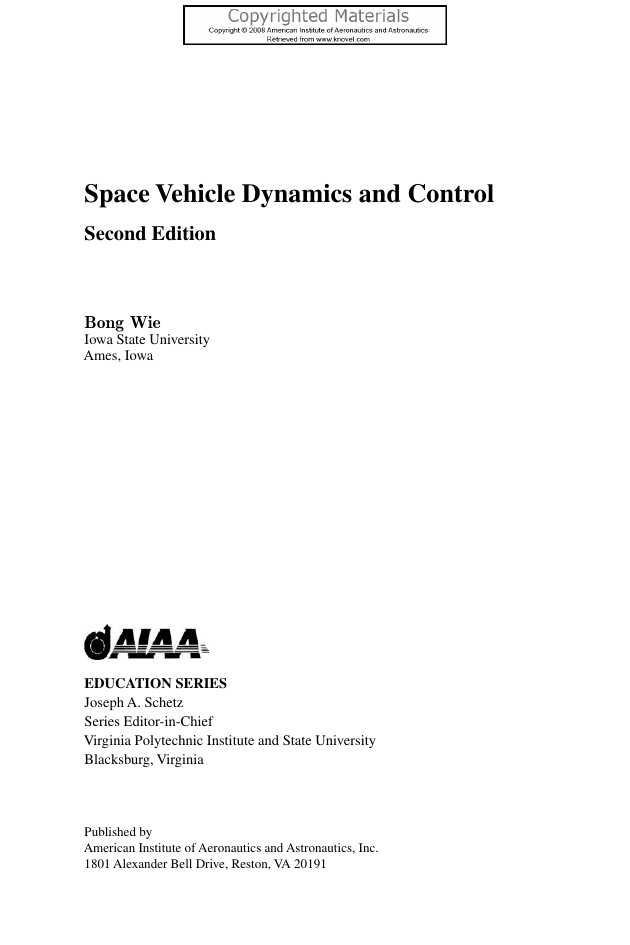
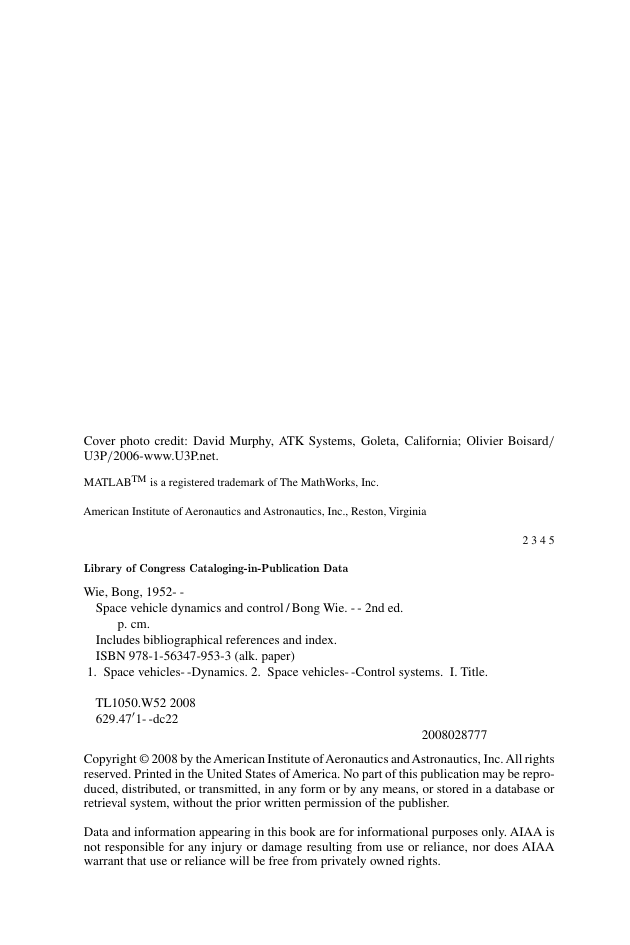
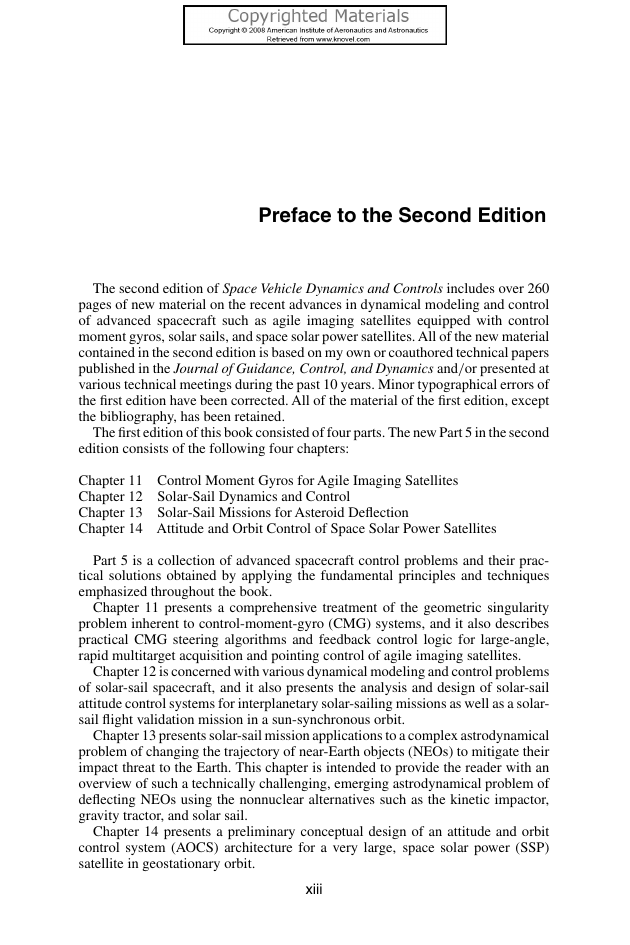
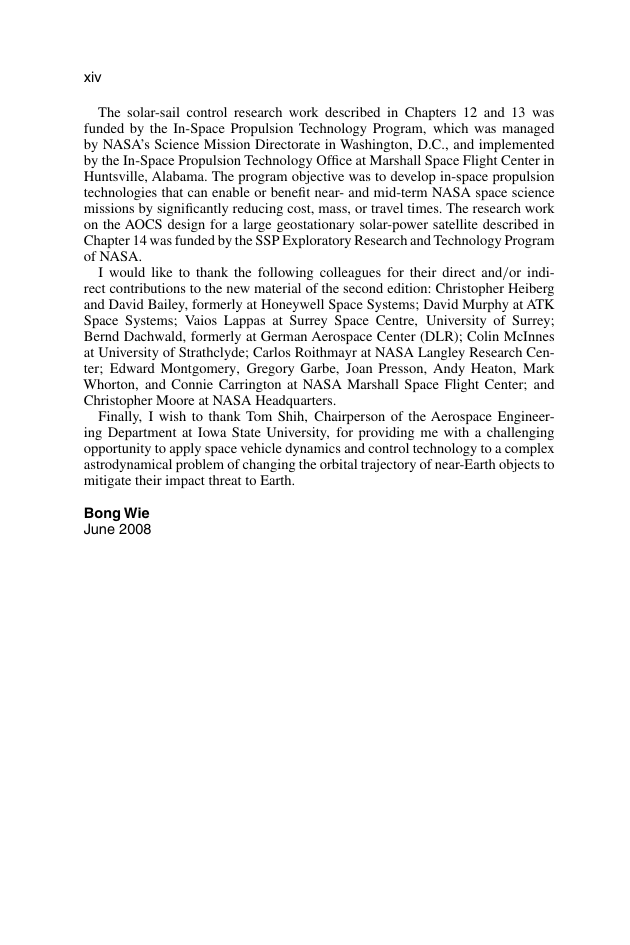
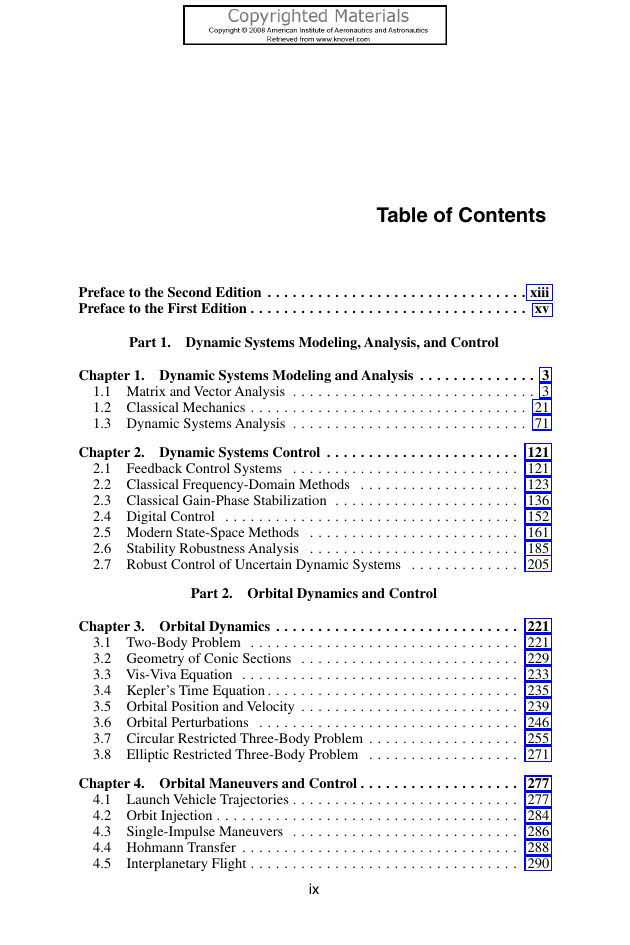

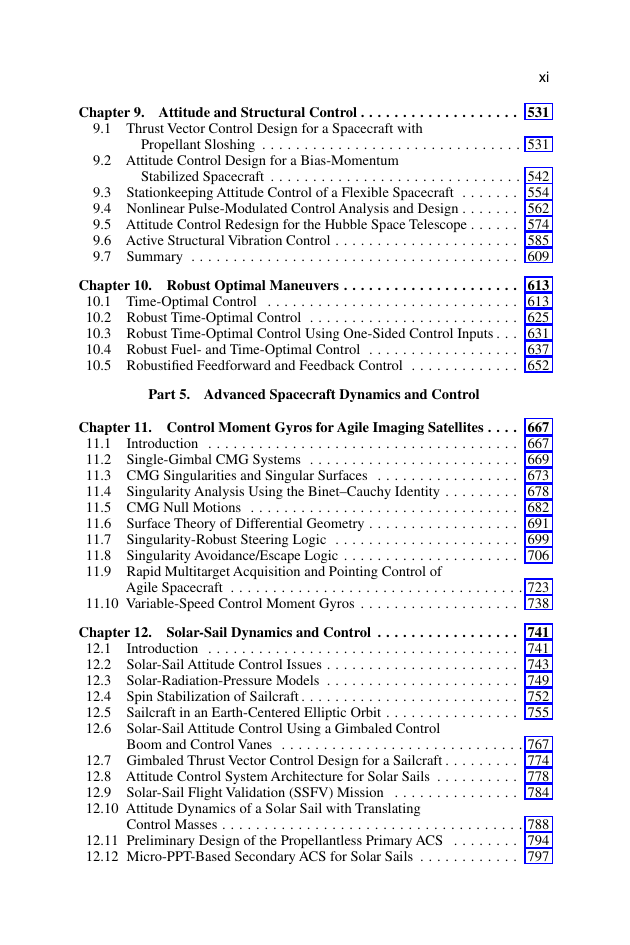
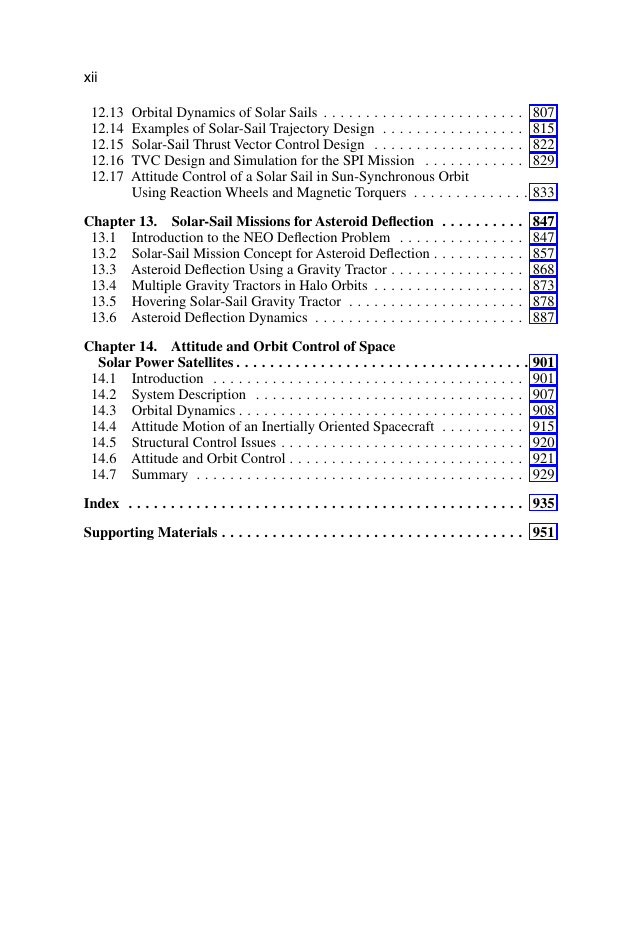








 2023年江西萍乡中考道德与法治真题及答案.doc
2023年江西萍乡中考道德与法治真题及答案.doc 2012年重庆南川中考生物真题及答案.doc
2012年重庆南川中考生物真题及答案.doc 2013年江西师范大学地理学综合及文艺理论基础考研真题.doc
2013年江西师范大学地理学综合及文艺理论基础考研真题.doc 2020年四川甘孜小升初语文真题及答案I卷.doc
2020年四川甘孜小升初语文真题及答案I卷.doc 2020年注册岩土工程师专业基础考试真题及答案.doc
2020年注册岩土工程师专业基础考试真题及答案.doc 2023-2024学年福建省厦门市九年级上学期数学月考试题及答案.doc
2023-2024学年福建省厦门市九年级上学期数学月考试题及答案.doc 2021-2022学年辽宁省沈阳市大东区九年级上学期语文期末试题及答案.doc
2021-2022学年辽宁省沈阳市大东区九年级上学期语文期末试题及答案.doc 2022-2023学年北京东城区初三第一学期物理期末试卷及答案.doc
2022-2023学年北京东城区初三第一学期物理期末试卷及答案.doc 2018上半年江西教师资格初中地理学科知识与教学能力真题及答案.doc
2018上半年江西教师资格初中地理学科知识与教学能力真题及答案.doc 2012年河北国家公务员申论考试真题及答案-省级.doc
2012年河北国家公务员申论考试真题及答案-省级.doc 2020-2021学年江苏省扬州市江都区邵樊片九年级上学期数学第一次质量检测试题及答案.doc
2020-2021学年江苏省扬州市江都区邵樊片九年级上学期数学第一次质量检测试题及答案.doc 2022下半年黑龙江教师资格证中学综合素质真题及答案.doc
2022下半年黑龙江教师资格证中学综合素质真题及答案.doc